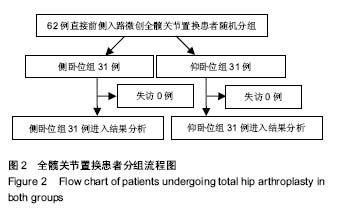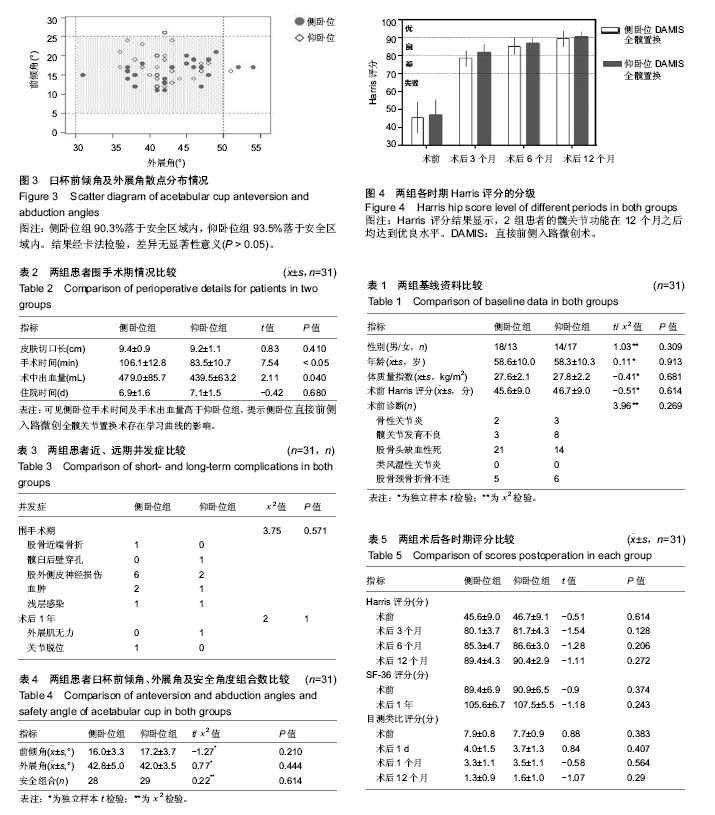| [1] Wang R,Li XX,Gao MX,et al.Comparison of clinical efficacy between minimally invasive total hip artliroplasty and traditional total hip arthroplasty:a systematic review.Zhongguo Gu Shang.2016;29(2):172-178.[2] Müller DA, Zingg PO, Dora C. Anterior minimally invasive approach for total hip replacement:five-year survivorship and learning curve. Hip Int. 2014;24(3):277-283.[3] 高辉,黄世桥.DAMIS入路对同期双侧全髋关节置换术患者术后康复的影响[J].赣南医学院学报,2016,36(4):585-589.[4] Brian A,Dennis K.High complication rate with anterior total hip arthroplasties on a fracture table.Clin Orthop Relat Res. 2011;469(2): 503-507.[5] Spaans AJ, van den Hout JA, Bolder SB.High complication rate in the early experience of minimally invasive total hip arthroplasty by the direct anterior approach. Acta Orthopaedica. 2012;83(4):342-346.[6] 罗正亮,陈敏,尚希福,等.侧卧位直接前方入路与后外侧入路全髋关节置换临床疗效比较[J].中华医学杂志,2016,96(35):2807-2812.[7] Chen M, Luo Z, Ji X, et al.Direct anterior approach for total hip arthroplasty in the lateral decubitus position:our experiences and early results. J Arthroplasty. 2016;32(1):131-138.[8] Michel MC,Witschger P.Micro Hip:a minimally invasive procedure for total hip replacement surgery using a modified Smith-Peterson approach. Ortop Traumatol Rehabil. 2007;9(1):46-51.[9] Rudert M,Horas K,Hoberg M,et al.The Wuerzburg procedure:the tensor fasciae latae perforator is a reliable anatomical landmark to clearly identify the Hueter interval when using the minimally-invasive direct anterior approach to the hip joint.BMC Musculoskelet Disord. 2016;17(1):1-5.[10] 时利军,白禹,高福强,等.鸡尾酒疗法减少全髋关节置换后的隐性失血[J].中国组织工程研究,2016,20(48):7156-7162.[11] 艾芳,高辉,何春耒.前侧入路微创髋关节置换术快速康复护理[J].赣南医学院学报,2017,37(1),30-31.[12] Harris WH.Traumatic arthritis of the hip after dislocation and acetabular fractures: treatment by mold arthroplasty. An end-result study using a new method of result evaluation. J Bone Joint Surg Am. 1969;51(4): 737-755.[13] 叶山山,陈震东,何春耒,等.单侧DAMIS术中股外侧皮神经损伤对患者髋关节功能恢复及生活质量的影响[J].赣南医学院学报.2017,37(1): 9-13, 17.[14] 罗正亮,尚希福,胡飞,等.全髋关节置换术治疗创伤性股骨头缺血性坏死的疗效分析[J].中华医学杂志,2014,9(23):1773-1776.[15] Pradhan R.Planar anteversion of the acetabular cup as determined from plain anteroposterior radiographs.J Bone Joint Surg Br. 1999; 81(3):431-435.[16] Lewinnek GE,Lewis JL,Tarr R,et al.Dislocations after total hip-replacement arthroplasties.J Bone Joint Surg Am. 1978;60(2): 217-220.[17] 高辉.微创全髋关节置换术手术入路的研究进展[J].赣南医学院学报, 2017,37(1):2-4.[18] 王世栋,邓雪飞,韩卉,等.Hueter间隙在髋关节前路手术中的应用解剖学观察[J].中国骨与关节外科,2013,6(1):43-46.[19] 陈震东,叶山山,徐房添,等.赣南医学院学报.DAMIS全髋关节置换术:初期经验与早期结果[J].赣南医学院学报,2017,37(1),22-25.[20] 杨永超.直接前侧微创入路全髋关节置换术临床应用研究[J].新乡医学院学报, 2013,30(12):969-971,974.[21] de Steiger RN, Lorimer M,Solomon M. What is the learning curve for the anterior approach for total hip arthroplasty? Clin Orthop Relat Res. 2015;473(12):3860-3866.[22] Cunningham RB. Dislocation following total hip arthroplasty: an overview of contributing factors. J Orthop Phys Assist. 2017;5(1):1-3.[23] Asayama I,Akiyeshi Y,Naito M,et al.Intraoperative pelvic motion in total hip arthroplasty.J Arthmplasty. 2004;19(8):992-997.[24] Lembeck B,Mueller O, Reize P, et al. Pelvic tilt makes aeetabular cup navigation inaccurate. Acta Orthop. 2005;76(4):517-523.[25] Kanazawa M, Nakashima Y, Ohishi M, et al. Pelvic tilt and movement during total hiparthroplasty in the lateral decubitus position, Modern Rheumatology. Mod Rheumatol. 2016;26(3):435-440.[26] Lembeck B, Mueller O, Reize P, et al. Pelvic tilt makes acetabular cup navigation inaccurate.Acta Orthopaedica. 2005;76(4):517-523.[27] Mccarthy TF,Alipit V,Nevelos J,et al.Acetabular Cup Anteversion and Inclination in Hip Range of Motion to Impingement. J Arthroplasty. 2016;31(9):264-268.[28] Melman WP,Mollen BP,Kollen BJ,et al.First experiences with the direct anterior approach in lateral decubitus position:learning curve and 1 year complication rate. Hip Int. 2015;25(3):251-257. |
.jpg)


.jpg)
.jpg)